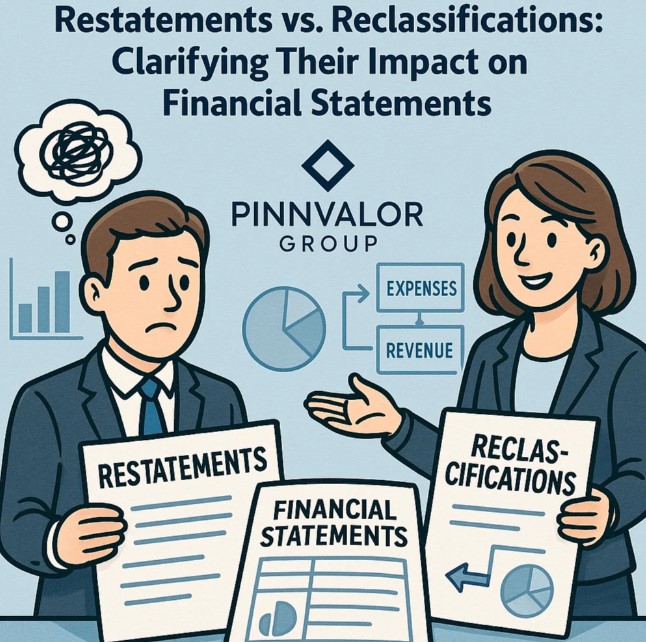
Restatements vs. Reclassifications: Clarifying Their Impact on Financial Statements
Accurate financial reporting is the cornerstone of trust between a company and its stakeholders. Investors, creditors, regulators, and management rely on financial statements to make informed decisions. However, as companies prepare and finalize these statements, adjustments sometimes become necessary to correct errors or improve clarity. Two key types of adjustments often encountered are restatements and reclassifications.
While they may appear similar on the surface, restatements and reclassifications have fundamentally different causes, implications, and impacts on financial reporting. Understanding these differences is critical for anyone involved in financial analysis, auditing, or corporate governance.
What’s the real impact when a company restates versus simply reclassifies its financial data?
Restatements correct material errors, reshaping how stakeholders view a company’s financial health. Meanwhile, reclassifications simply refine presentation without changing the numbers.
What is a Restatement?
A restatement occurs when a company revises previously issued financial statements to correct material errors or omissions. These errors might stem from mistakes in applying accounting principles, miscalculations, or even fraud. Restatements affect the accuracy of past financial reports and, consequently, can have serious consequences for a company’s credibility and investor confidence.
When Do Restatements Happen?
- Discovery of accounting errors, such as incorrect revenue recognition or improper expense recording
- Unintentional omission of significant transactions or liabilities
- Changes in accounting standards that require retroactive adjustments
- Detection of fraud or intentional misstatements
Because restatements affect reported earnings, assets, or liabilities, companies are required to clearly disclose these changes, explain their nature, and provide corrected financial statements.
What is a Reclassification?
Unlike restatements, reclassifications do not correct errors but involve shifting amounts within the financial statements to improve presentation or better reflect the nature of transactions. Reclassifications rearrange data among accounts or categories without altering the total amounts reported.
Common Examples of Reclassifications
- Moving certain expenses from operating expenses to cost of goods sold
- Shifting liabilities between current and non-current classifications
- Reclassifying assets from one category to another for clearer reporting
Reclassifications enhance the comparability and readability of financial statements, helping users better understand the company's financial position and performance.

Key Differences Between Restatements and Reclassifications
| Factor | Restatement | Reclassification |
|---|---|---|
| Purpose | Correct material errors in prior statements | Improve presentation without changing totals |
| Effect on Totals | Alters previously reported financial totals | No change to overall totals |
| Frequency | Less frequent, often triggered by audits or investigations | More routine and part of reporting updates |
| Impact on Stakeholders | Can damage credibility and require reassessment | Generally seen as normal reporting adjustments |
| Disclosure Requirements | Detailed disclosure and explanation necessary | Disclosure required but less detailed |
Why Does the Distinction Matter?
For investors, auditors, and regulators, knowing whether a change is a restatement or a reclassification matters greatly:
- Investor Confidence: Restatements can shake confidence as they suggest prior financial reports were unreliable. Reclassifications, by contrast, aim to clarify information without changing financial realities.
- Decision-Making: Restatements may lead to reassessment of company valuation or creditworthiness, while reclassifications typically do not.
- Regulatory Impact: Restatements often invite regulatory scrutiny and may trigger penalties, whereas reclassifications are routine and less likely to cause concern.
How Should Companies Approach These Adjustments?
- Maintain Strong Controls: Prevent errors leading to restatements by implementing rigorous internal controls and regular reviews.
- Be Transparent: Clearly disclose and explain restatements or reclassifications in the notes to financial statements. Transparency builds trust.
- Consistency: Apply accounting policies and classifications consistently across reporting periods for comparability.
- Engage Auditors Early: Work closely with auditors to ensure proper handling of any restatements or reclassifications.
Conclusion
Restatements and reclassifications serve different purposes but are both integral to the accuracy and clarity of financial reporting. Restatements address fundamental errors that affect reported results, signaling the need for stakeholders to re-examine prior assessments. Reclassifications, meanwhile, optimize the presentation of data without altering financial outcomes, helping users better navigate complex statements.
For professionals and stakeholders alike, recognizing these differences ensures more informed interpretations and reinforces the integrity of financial communication.
